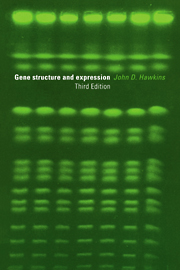Book contents
- Frontmatter
- Contents
- Introduction to the third edition
- Introduction to the second edition
- Introduction to the first edition
- List of abbreviations
- 1 Deoxyribonucleic acid (DNA)
- 2 Ribonucleic acid (RNA)
- 3 Methodology
- 4 Prokaryotic DNA replication and gene expression
- 5 The operon concept
- 6 Eukaryotic gene organisation and replication
- 7 Eukaryotic transcription
- 8 Post-transcriptional processing of RNA
- 9 Oncogenes
- 10 Haemoglobin
- 11 Proteins of the immune system
- 12 Some gene families
- 13 Mitochondrial and chloroplast genomes
- 14 Different and evolving genomes
- Glossary
- Reading lists
- Index
10 - Haemoglobin
Published online by Cambridge University Press: 05 June 2012
- Frontmatter
- Contents
- Introduction to the third edition
- Introduction to the second edition
- Introduction to the first edition
- List of abbreviations
- 1 Deoxyribonucleic acid (DNA)
- 2 Ribonucleic acid (RNA)
- 3 Methodology
- 4 Prokaryotic DNA replication and gene expression
- 5 The operon concept
- 6 Eukaryotic gene organisation and replication
- 7 Eukaryotic transcription
- 8 Post-transcriptional processing of RNA
- 9 Oncogenes
- 10 Haemoglobin
- 11 Proteins of the immune system
- 12 Some gene families
- 13 Mitochondrial and chloroplast genomes
- 14 Different and evolving genomes
- Glossary
- Reading lists
- Index
Summary
Genes for globins are found in two clusters
Haemoglobin consists of four polypeptide chains of two different though similar types, which are folded round each other in an orderly and compact fashion. The two types of chain, designated α and β, are present in equal amounts. They show a very substantial degree of homology – in humans 43% of the residues are identical. During synthesis of haemoglobin these polypeptides (known as globins) are made first and then each binds a molecule of haem very firmly.
Several different β-like globins are synthesised at different stages of life (Table 10.1). In the early embryo, the ∊-chain is synthesised in the yolk sac. Later, synthesis switches to the foetal liver which makes two forms of the γ-chain, known as Aγ and Gγ, since they contain either an alanine or a glycine residue at one particular position. Finally, just before birth, β-chain synthesis commences in the bone marrow, along with a very small amount of the almost identical δ-chain that differs from the β-chain in only ten residues.
The δ-gene is transcribed at a much lower efficiency than the β-gene so that δ-chain mRNA is produced in much smaller amounts than the β-chain mRNA. The sequences of the two genes differ in the 5′-flanking regions (Fig. 10.1), but it is not possible to pinpoint the reasons for their different rates of transcription.
- Type
- Chapter
- Information
- Gene Structure and Expression , pp. 133 - 140Publisher: Cambridge University PressPrint publication year: 1996



